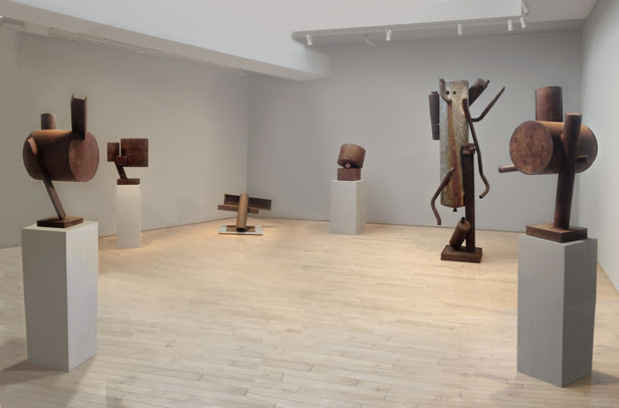Richard Stankiewicz “Syncopated Steel: 70s Sculptures”
Washburn Gallery

This event has ended.
A believer that all objects and all materials possessed an inherent internal life, Richard Stankiewicz turned mechanical refuse—shards of metal gadgets as well as cleanly cut industrial steel—into lively, animated constructions. His works of the 1950s were assemblages of brake drums, stove fittings, rusty wires and ball bearings infused with an intense animal energy. Titles like Twittering Machine, Secretary, Soldier, Bride, and Speckle Bird Shy conveyed their easily perceived life-like character.
With few exceptions, the works in this current exhibition demonstrate the artist’s ability to bring geometrically regular steel shapes like I-beams, tubes, and butt ends into quivering syncopation. The gangly cartoon character of 1963, seemingly out of place in this company, is the lone survivor of Stankiewicz’s community of personae with deep-set eyes and flailing limbs. The rest, all works of the 1970s, may sometimes evoke a bird perched on a single leg or resolve themselves into rhythmic arrangements of stacked, non-referential forms. Whatever appearance they assume, all of them are instilled with a living spirit.
Stankiewicz grew up in rust-belt Detroit during the Depression. He played in sandlots on the outskirts of factories and rail yards and attended Cass Technical High School, which trained students for employment as mechanical draftsmen and engineers in the automobile industry. A stint in the Navy during World War II, however, took him to the northwest coast, where he met artists associated with Morris Graves and Mark Tobey and had his first encounter with Asian art. After the war he studied painting with Hans Hofmann in New York, and sculpture with Ossip Zadkine in Paris. He became a member of the Hansa Gallery, an artists’ cooperative on East Twelfth Street that brought him into contact with Wolf Kahn, Jan Muller, Jane Wilson, Jean Follett, Allan Kaprow, and George Segal, among others.
After the gallery closed in 1959 he showed at Eleanor Ward’s Stable Gallery, where works by Isamu Noguchi, Wilfred Zogbaum, Joseph Cornell, Louise Bourgeois and (somewhat later) Andy Warhol were regularly featured. After leaving New York for rural western Massachusetts, beginning a family and a teaching career at the State University of New York at Albany, where he established the sculpture studio, he traveled to Australia in 1969. There he improved what a colleague once called his “chicken shit” welding technique under the tutelage of experienced industrial metallurgists and steel workers. At a foundry in Sydney he was able to produce seventeen large-scale works made from freshly milled steel.
On his return to the States Stankiewicz located a foundry in Pittsfield, Massachusetts, where he continued to refine his new-found skill at balancing and cantilevering the reductively shaped steel elements that were now available to him. The works on view in this exhibition date primarily from this period, when Stankiewicz worked at the Nash Foundry. These works all exhibit the warm hue of the fresh steel that the artist systematically watered to achieve a soft, granular surface. They were first shown in 1972 at the Zabriskie Gallery in New York (and later in Paris). Virginia Zabriskie was an enthusiastic supporter of the artist in this later phase of career, and she maintained a lifelong friendship with him.
While the untitled 1963 figure shows a more whimsical side of Stankiewicz’s passion for recycling steel, the sculptures made from industrial stock align more comfortably with the cool austerity of Minimalist composition. Yet the warmth of their surfaces and the wit of their configurations let us know that here too he retains the power to breathe life into seemingly expressionless, inert matter.
Emmie Donadio, June 2014
Chief Curator, Middlebury College Museum of Art
Media
Schedule
from September 10, 2014 to November 01, 2014
Opening Reception on 2014-09-10 from 18:00 to 20:00